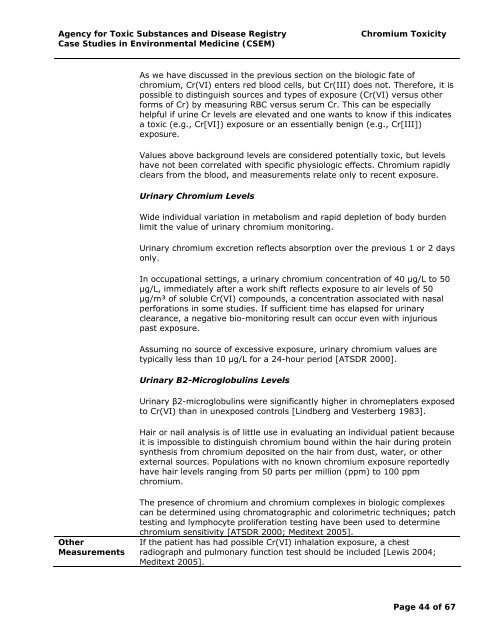(Cr) Toxicity | ATSDR - CSEM - Agency for Toxic Substances and ...
(Cr) Toxicity | ATSDR - CSEM - Agency for Toxic Substances and ...
(Cr) Toxicity | ATSDR - CSEM - Agency for Toxic Substances and ...
Create successful ePaper yourself
Turn your PDF publications into a flip-book with our unique Google optimized e-Paper software.
<strong>Agency</strong> <strong>for</strong> <strong>Toxic</strong> <strong>Substances</strong> <strong>and</strong> Disease Registry Chromium <strong><strong>Toxic</strong>ity</strong><br />
Case Studies in Environmental Medicine (<strong>CSEM</strong>)<br />
Other<br />
Measurements<br />
As we have discussed in the previous section on the biologic fate of<br />
chromium, <strong>Cr</strong>(VI) enters red blood cells, but <strong>Cr</strong>(III) does not. There<strong>for</strong>e, it is<br />
possible to distinguish sources <strong>and</strong> types of exposure (<strong>Cr</strong>(VI) versus other<br />
<strong>for</strong>ms of <strong>Cr</strong>) by measuring RBC versus serum <strong>Cr</strong>. This can be especially<br />
helpful if urine <strong>Cr</strong> levels are elevated <strong>and</strong> one wants to know if this indicates<br />
a toxic (e.g., <strong>Cr</strong>[VI]) exposure or an essentially benign (e.g., <strong>Cr</strong>[III])<br />
exposure.<br />
Values above background levels are considered potentially toxic, but levels<br />
have not been correlated with specific physiologic effects. Chromium rapidly<br />
clears from the blood, <strong>and</strong> measurements relate only to recent exposure.<br />
Urinary Chromium Levels<br />
Wide individual variation in metabolism <strong>and</strong> rapid depletion of body burden<br />
limit the value of urinary chromium monitoring.<br />
Urinary chromium excretion reflects absorption over the previous 1 or 2 days<br />
only.<br />
In occupational settings, a urinary chromium concentration of 40 μg/L to 50<br />
μg/L, immediately after a work shift reflects exposure to air levels of 50<br />
μg/m³ of soluble <strong>Cr</strong>(VI) compounds, a concentration associated with nasal<br />
per<strong>for</strong>ations in some studies. If sufficient time has elapsed <strong>for</strong> urinary<br />
clearance, a negative bio-monitoring result can occur even with injurious<br />
past exposure.<br />
Assuming no source of excessive exposure, urinary chromium values are<br />
typically less than 10 μg/L <strong>for</strong> a 24-hour period [<strong>ATSDR</strong> 2000].<br />
Urinary Β2-Microglobulins Levels<br />
Urinary β2-microglobulins were significantly higher in chromeplaters exposed<br />
to <strong>Cr</strong>(VI) than in unexposed controls [Lindberg <strong>and</strong> Vesterberg 1983].<br />
Hair or nail analysis is of little use in evaluating an individual patient because<br />
it is impossible to distinguish chromium bound within the hair during protein<br />
synthesis from chromium deposited on the hair from dust, water, or other<br />
external sources. Populations with no known chromium exposure reportedly<br />
have hair levels ranging from 50 parts per million (ppm) to 100 ppm<br />
chromium.<br />
The presence of chromium <strong>and</strong> chromium complexes in biologic complexes<br />
can be determined using chromatographic <strong>and</strong> colorimetric techniques; patch<br />
testing <strong>and</strong> lymphocyte proliferation testing have been used to determine<br />
chromium sensitivity [<strong>ATSDR</strong> 2000; Meditext 2005].<br />
If the patient has had possible <strong>Cr</strong>(VI) inhalation exposure, a chest<br />
radiograph <strong>and</strong> pulmonary function test should be included [Lewis 2004;<br />
Meditext 2005].<br />
Page 44 of 67

















